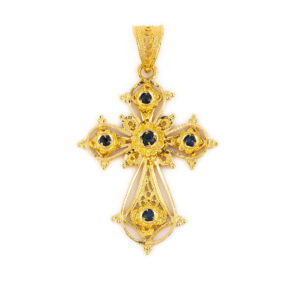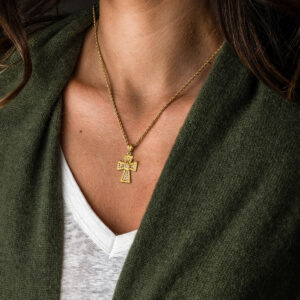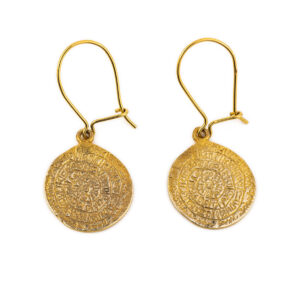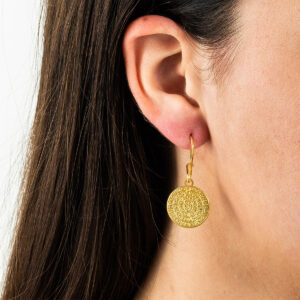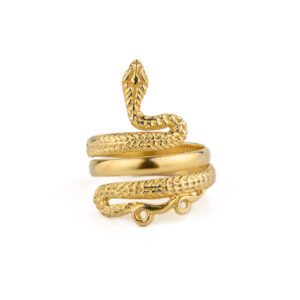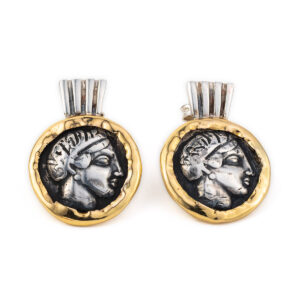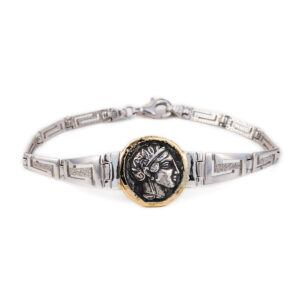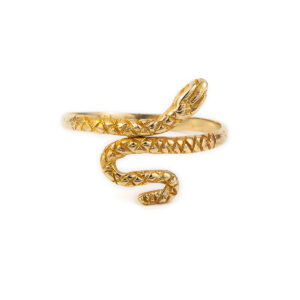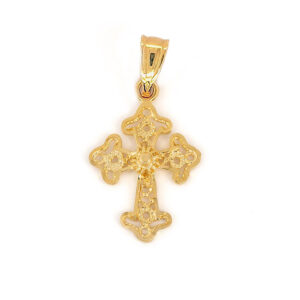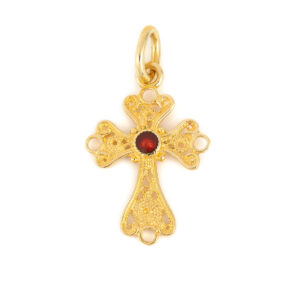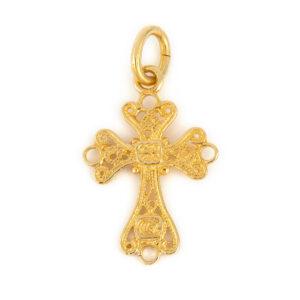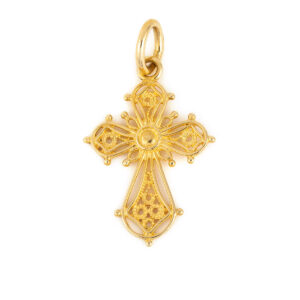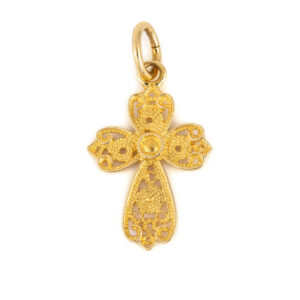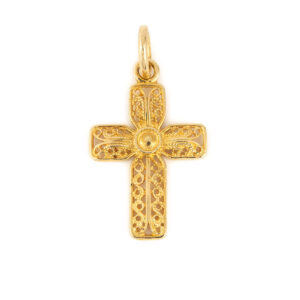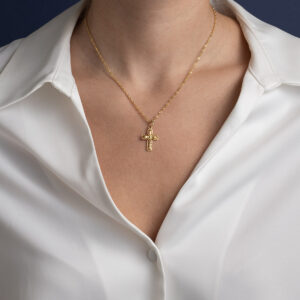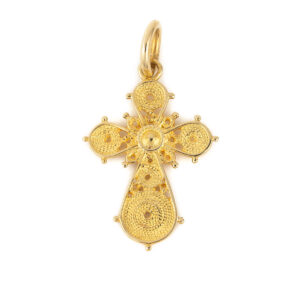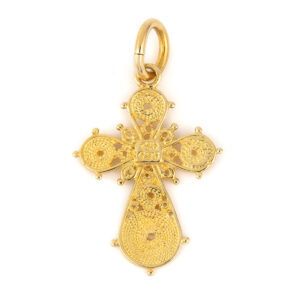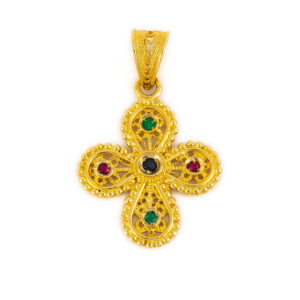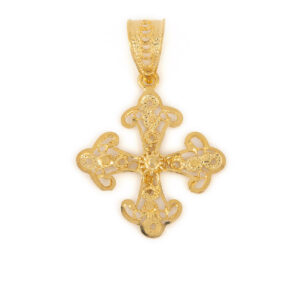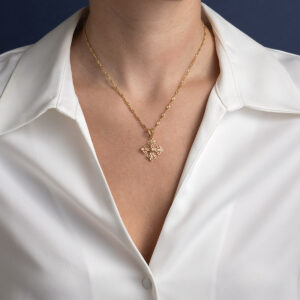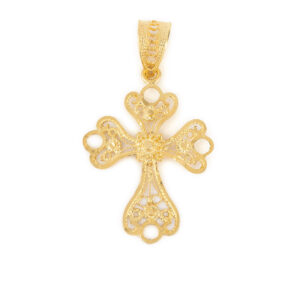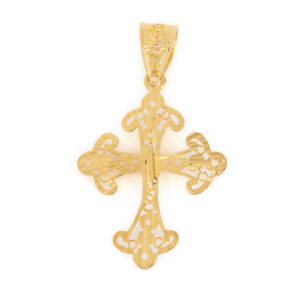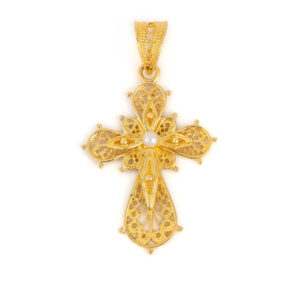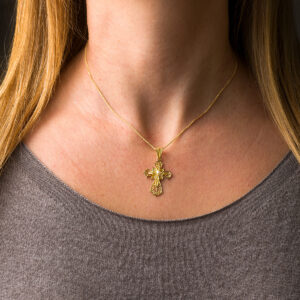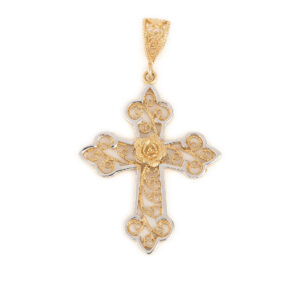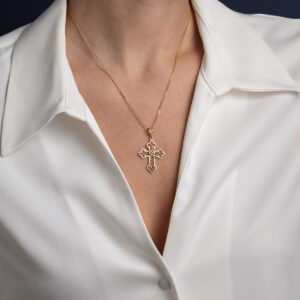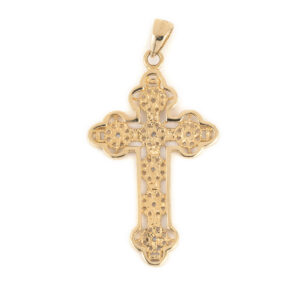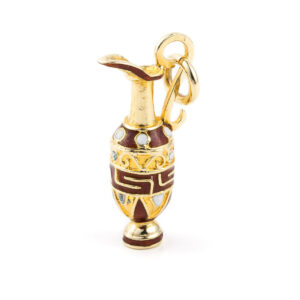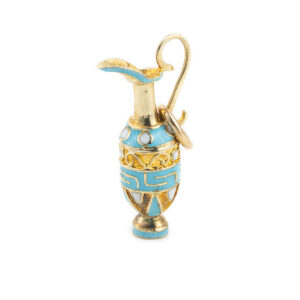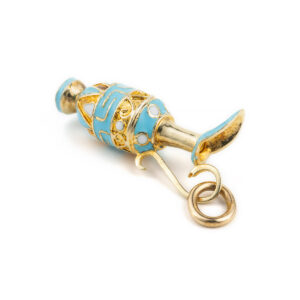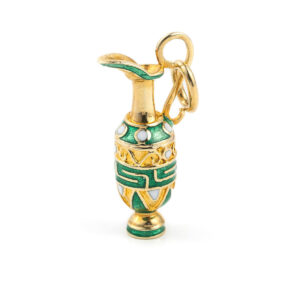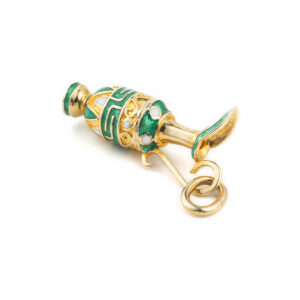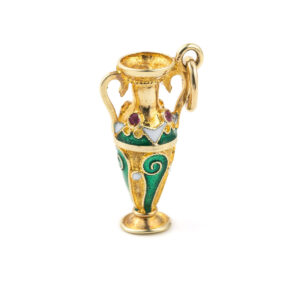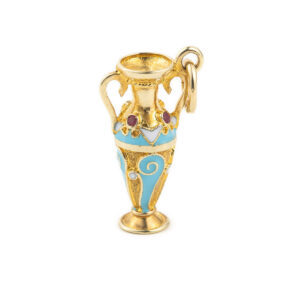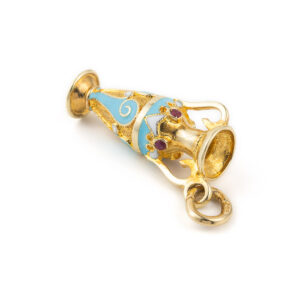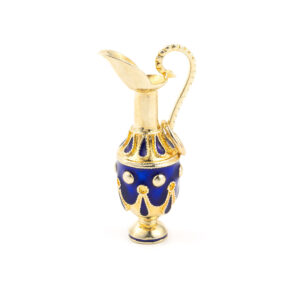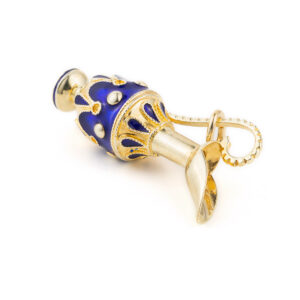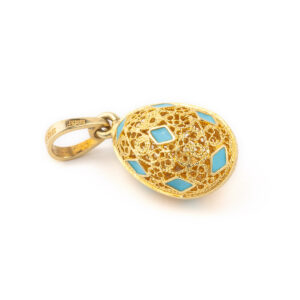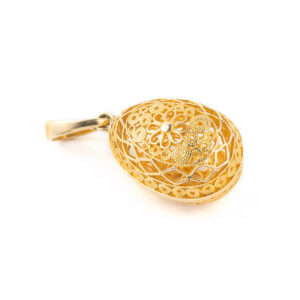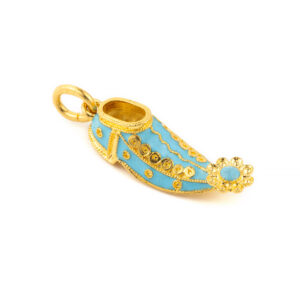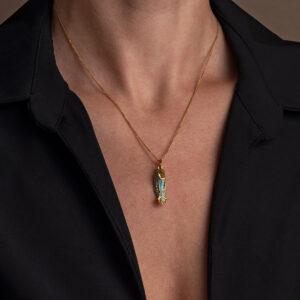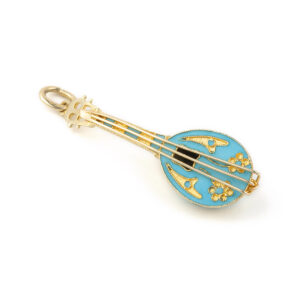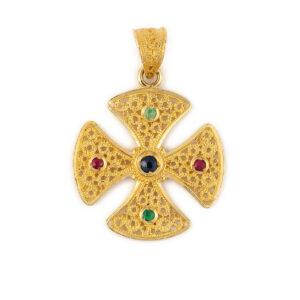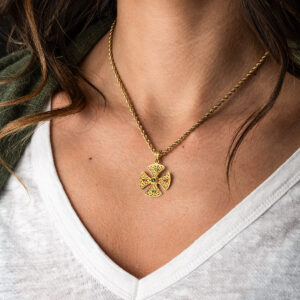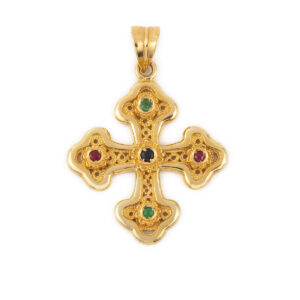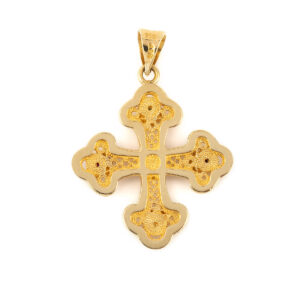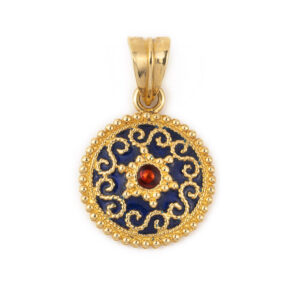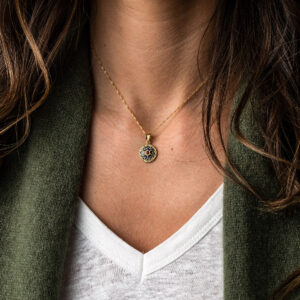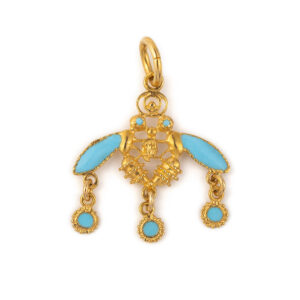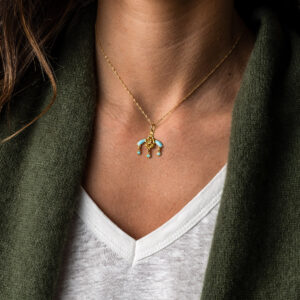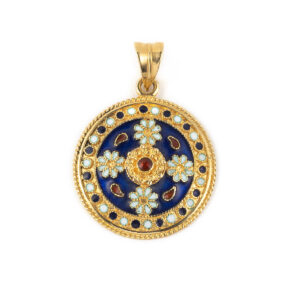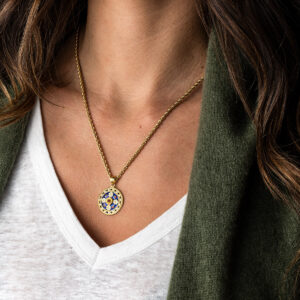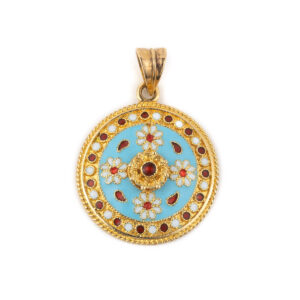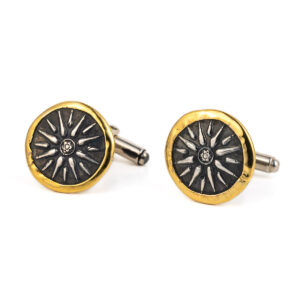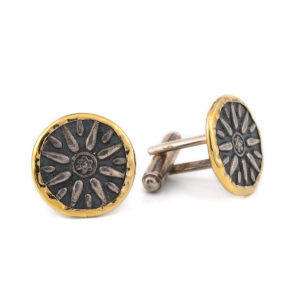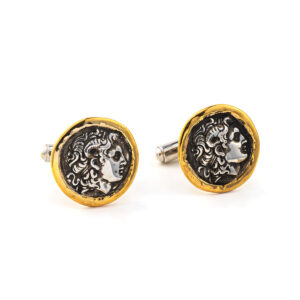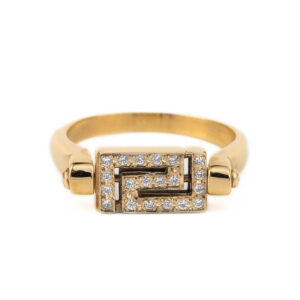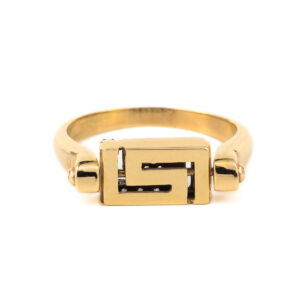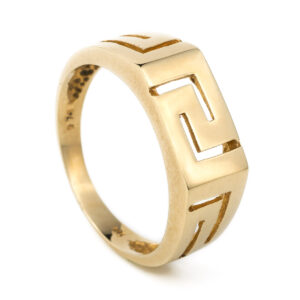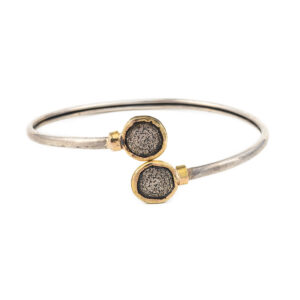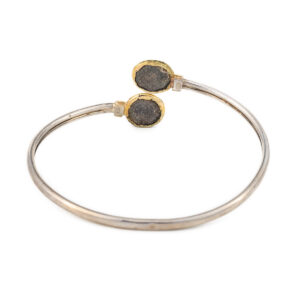18K Gold Cross with Sapphire
798,00€Byzantine Cross is embellished with a fine filigree and gemstones. Choose among emeralds, rubies, sapphires or multi stones.
Handmade with the great attention to detail. Inspired by Byzantine art.
Made in 18k gold
Filigree is a delicate kind of jewellery metalwork, made with tiny beads or twisted threads, or both in combination, soldered together or to the surface of an object of the same metal and arranged in artistic motifs. The art of filigree dates back to ancient history. The first of the found jewelry in this technique have been found in Mesopotamia and dates to thousands of years BC. In the ancient world and particularly in Asia Minor, this art grew were at the highest level.
18K Gold Byzantine Cross with Swarovski
809,00€Byzantine Cross is embellished with a fine filigree and the great attention to detail. The decoration of this cross shows the influence of the Byzantine art.
Made in 18k gold.
Handmade item
The chain shown is our 14K Gold Rope Chain (not included).
Filigree is a delicate kind of jewellery metalwork, made with tiny beads or twisted threads, or both in combination, soldered together or to the surface of an object of the same metal and arranged in artistic motifs. The art of filigree dates back to ancient history. The first of the found jewelry in this technique have been found in Mesopotamia and dates to thousands of years BC. In the ancient world and particularly in Asia Minor, this art grew were at the highest level.
14K Gold Phaistos Disk Dangle Earrings
850,00€This beautiful pair of earrings representing the disc of Phaistos. The Phaistos Disc is a disk of fired clay from the Minoan palace of Phaistos on the island of Crete. Now, the island of Crete is part of modern Greece. The disc was discovered in 1908 by the Italian archaeologist Luigi Pernier in the Minoan palace-site of Phaistos. While it is not clear that it is a script, most attempted decipherments assume that it is; most additionally assume a syllabary, others an alphabet or logography or a calendar, making it one of the most famous mysteries of archaeology. The disk is about 15 cm in diameter and covered on both sides with a spiral of stamped symbols. The disc features 241 tokens, comprising 45 distinct signs, which were apparently made by pressing hieroglyphic “seals” into a disc of soft clay, in a clockwise sequence spiraling toward the center of the disk. This unique object is now on display at the archaeological museum of Heraklion.
Made in 14k gold.
Handmade item.
Δαχτυλίδι Φίδι – 14Κ Χρυσό
810,00€14K Gold Snake Ring
Handmade item. As in all handmade items there may be small differences in weight and dimensions and this is what makes them unique and precious.
Made in 14k gold.
14K Gold Sterling Silver Goddess Athena Earrings
324,00€Α beautiful and elegant pair of earrings with Goddess Athena.
Made in 14K Gold and 925⁰ sterling silver.
Handmade item. As in all handmade items there may be small differences in weight and dimensions and this is what makes them unique and precious.
Goddess Athena Coin Link Bracelet – 14K Gold and 925 Sterling Silver
255,00€Α beautiful and elegant bracelet with Goddess Athena and the owl.
Made of 14K Gold and 925⁰ sterling silver.
Handmade item. As in all handmade items there may be small differences in weight and dimensions and this is what makes them unique and precious.
Goddess Athena and Owl – Athenian silver tetradrachm
Dracma was the currency used in Greece during several periods in its history.
The tetradrachm was an Ancient Greek silver coin equivalent to fourdrachmae in Athens it replaced the earlier “heraldic” type of didrachms and it was in wide circulation from ca. 510 to ca. 38 BC.
This coin belongs to the so-called “new style Athenian coins” minted between 166 and 64 B.C. and is considered one of the most popular ancient Greek coins which illustrate the portrait of Goddess Athena on the one side and the wisdom owl on the other. Athena is an ancient Greek goddess associated with wisdom, handicraft, and warfare.
Athena was regarded as the patron and protectress of various cities across Greece, particularly the city of Athens, from which she most likely received her name. She’s usually shown in art wearing a helmet and holding a spear. Her major symbols include owls, olive trees, and snakes. Her temples were located atop the fortified Acropolis in the central part of the city. The Parthenon on the Athenian Acropolis is dedicated to her, along with numerous other temples and monuments. Her main festival in Athens was the Panathenaia, which was celebrated in midsummer and was the most important festival on the Athenian calendar.
In the classical Olympian pantheon, Athena was regarded as the favorite daughter of Zeus. The owl traditionally accompanies Athena. Because of such association, the owl has been used as a symbol of knowledge and wisdom. The inscriptions contain the city’s “national” appellation (“ΑΘΕ», i.e. “of the Athenians”).
Alexander The Great Ring – 14K Gold and Sterling Silver
242,00€Ring inspired by the Ancient Greek coin of Alexander the great.
Made in 14k gold and 925 sterling silver.
Alexander the Great the King of Macedonia is considered one of the most important forms of world history.
Handmade item.
14K Gold Snake Ring
288,00€14K Gold Snake Ring
Handmade item. As in all handmade items there may be small differences in weight and dimensions and this is what makes them unique and precious.
Made in 14k gold
Βυζαντινός Σταυρός από Χρυσό 14Κ
176,00€Ο Βυζαντινός σταυρός διακοσμημένος με λεπτό φιλιγκράν και μεγάλη προσοχή στη λεπτομέρεια. Η διακόσμηση αυτού του σταυρού δείχνει την επιρροή της βυζαντινής τέχνης.
Κατασκευασμένος από χρυσό 14 καρατίων.
Χειροποίητο ελληνικό κόσμημα.
Το φιλιγκράν είναι ένα λεπτό είδος μεταλλικής κοσμηματοποιίας, κατασκευασμένο με μικροσκοπικές χάντρες ή στριφτά νήματα, ή και τα δύο σε συνδυασμό, συγκολλημένα μεταξύ τους ή στην επιφάνεια ενός αντικειμένου από το ίδιο μέταλλο και τοποθετημένα σε καλλιτεχνικά μοτίβα. Η τέχνη του φιλιγκράν χρονολογείται από την αρχαία ιστορία. Τα πρώτα από τα ευρεθέντα κοσμήματα με αυτή την τεχνική έχουν βρεθεί στη Μεσοποταμία και χρονολογούνται χιλιάδες χρόνια π.Χ. Στον αρχαίο κόσμο και ιδιαίτερα στη Μικρά Ασία, η τέχνη αυτή αναπτύχθηκε ήταν στο υψηλότερο επίπεδο.
Βυζαντινός Χρυσός Σταυρός 18Κ Φιλιγκράν με Κόκκινο Σμάλτο Αδελαΐδα
273,00€Αυτός ο σταυρός ονομάζεται «Αδελαΐδα». Η Αδελαΐδα από τον οίκο των Γκέλφων ήταν κόρη του Ερρίκου Δούκα του Brunswick και πρώτη σύζυγος του Ανδρόνικου Γ’ Παλαιολόγου, μετέπειτα αυτοκράτορα των Ρωμαίων.
Βυζαντινός σταυρός διακοσμημένος με λεπτό φιλιγκράν και κόκκινο σμάλτο. Η διακόσμηση και το σχήμα αυτού του σταυρού δείχνουν την επιρροή της βυζαντινής τέχνης.
Κατασκευασμένος από χρυσό 18 καρατίων
Χειροποίητο ελληνικό κόσμημα.
Το φιλιγκράν είναι ένα λεπτό είδος μεταλλικής κοσμηματοποιίας, κατασκευασμένο με μικροσκοπικές χάντρες ή στριφτά νήματα, ή και τα δύο σε συνδυασμό, συγκολλημένα μεταξύ τους ή στην επιφάνεια ενός αντικειμένου από το ίδιο μέταλλο και τοποθετημένα σε καλλιτεχνικά μοτίβα. Η τέχνη του φιλιγκράν χρονολογείται από την αρχαία ιστορία. Τα πρώτα από τα ευρεθέντα κοσμήματα με αυτή την τεχνική έχουν βρεθεί στη Μεσοποταμία και χρονολογούνται χιλιάδες χρόνια π.Χ. Στον αρχαίο κόσμο και ιδιαίτερα στη Μικρά Ασία, η τέχνη αυτή αναπτύχθηκε ήταν στο υψηλότερο επίπεδο.
18K Χρυσός Βυζαντινός Σταυρός Φιλιγκράν Σοφία
275,00€Αυτός ο σταυρός ονομάζεται «Σοφία». Η Σοφία ήταν η αυτοκράτειρα σύζυγος του Ιουστίνου Β’ της Βυζαντινής Αυτοκρατορίας.
Βυζαντινός σταυρός διακοσμημένος με λεπτό φιλιγκράν και μεγάλη προσοχή στη λεπτομέρεια. Η διακόσμηση αυτού του σταυρού δείχνει την επιρροή της βυζαντινής τέχνης.
Κατασκευασμένος από χρυσό 18 καρατίων
Χειροποίητο ελληνικό κόσμημα.
Το φιλιγκράν είναι ένα λεπτό είδος μεταλλικής κοσμηματοποιίας, κατασκευασμένο με μικροσκοπικές χάντρες ή στριφτά νήματα, ή και τα δύο σε συνδυασμό, συγκολλημένα μεταξύ τους ή στην επιφάνεια ενός αντικειμένου από το ίδιο μέταλλο και τοποθετημένα σε καλλιτεχνικά μοτίβα. Η τέχνη του φιλιγκράν χρονολογείται από την αρχαία ιστορία. Τα πρώτα από τα ευρεθέντα κοσμήματα με αυτή την τεχνική έχουν βρεθεί στη Μεσοποταμία και χρονολογούνται χιλιάδες χρόνια π.Χ. Στον αρχαίο κόσμο και ιδιαίτερα στη Μικρά Ασία, η τέχνη αυτή αναπτύχθηκε ήταν στο υψηλότερο επίπεδο.
18K Χρυσός Βυζαντινός Σταυρός Φιλιγκράν Αριάδνη
290,00€Αυτός ο σταυρός ονομάζεται «Αριάδνη». Η Αριάδνη ήταν η αυτοκράτειρα σύζυγος του Ζήνωνα και του Αναστασίου Α΄ της Ρωμαϊκής Αυτοκρατορίας.
Βυζαντινός σταυρός διακοσμημένος με ένα λεπτό φιλιγκράν και τη μεγάλη προσοχή στη λεπτομέρεια. Αυτός ο μοναδικός και όμορφος σταυρός σχεδιάστηκε για να δείξει την αίγλη της βυζαντινής εποχής.
Εμπνευσμένος από τη βυζαντινή τέχνη.
Κατασκευασμένος από χρυσό 18 καρατίων
Χειροποίητο ελληνικό κόσμημα.
Το φιλιγκράν είναι ένα λεπτό είδος μεταλλικής κοσμηματοποιίας, κατασκευασμένο με μικροσκοπικές χάντρες ή στριφτά νήματα, ή και τα δύο σε συνδυασμό, συγκολλημένα μεταξύ τους ή στην επιφάνεια ενός αντικειμένου από το ίδιο μέταλλο και τοποθετημένα σε καλλιτεχνικά μοτίβα. Η τέχνη του φιλιγκράν χρονολογείται από την αρχαία ιστορία. Τα πρώτα από τα ευρεθέντα κοσμήματα με αυτή την τεχνική έχουν βρεθεί στη Μεσοποταμία και χρονολογούνται χιλιάδες χρόνια π.Χ. Στον αρχαίο κόσμο και ιδιαίτερα στη Μικρά Ασία, η τέχνη αυτή αναπτύχθηκε ήταν στο υψηλότερο επίπεδο.
Βυζαντινός Σταυρός Φιλιγκράν από Xρυσό 18Κ
315,00€Βυζαντινός σταυρός διακοσμημένος με λεπτό φιλιγκράν.
Εμπνευσμένος από τη βυζαντινή τέχνη.
Κατασκευασμένος από χρυσό 18 καρατίων
Χειροποίητο ελληνικό κόσμημα.
Το φιλιγκράν είναι ένα λεπτό είδος μεταλλικής κοσμηματοποιίας, κατασκευασμένο με μικροσκοπικές χάντρες ή στριφτά νήματα, ή και τα δύο σε συνδυασμό, συγκολλημένα μεταξύ τους ή στην επιφάνεια ενός αντικειμένου από το ίδιο μέταλλο και τοποθετημένα σε καλλιτεχνικά μοτίβα. Η τέχνη του φιλιγκράν χρονολογείται από την αρχαία ιστορία. Τα πρώτα από τα ευρεθέντα κοσμήματα με αυτή την τεχνική έχουν βρεθεί στη Μεσοποταμία και χρονολογούνται χιλιάδες χρόνια π.Χ. Στον αρχαίο κόσμο και ιδιαίτερα στη Μικρά Ασία, η τέχνη αυτή αναπτύχθηκε ήταν στο υψηλότερο επίπεδο.
18Κ Χρυσός Βυζαντινός Σταυρός Φιλιγκράν
315,00€Βυζαντινός σταυρός διακοσμημένος με κόκκους από πολύτιμο μέταλλο και λεπτό φιλιγκράν.Εμπνευσμένος από τη βυζαντινή τέχνη.
Κατασκευασμένος από χρυσό 18 καρατίων.
Χειροποίητο ελληνικό κόσμημα.
Η κοκκοποίηση (από τα λατινικά: granum = «κόκκος») είναι μια τεχνική κοσμηματοποιίας με την οποία η επιφάνεια ενός κοσμήματος καλύπτεται με μικρές σφαίρες ή κόκκους πολύτιμου μετάλλου. Η τεχνική θεωρείται ότι έχει τις ρίζες της στη Μεσοποταμία πριν από περίπου 5.000 χρόνια
Το φιλιγκράν είναι ένα λεπτό είδος μεταλλικής κοσμηματοποιίας, κατασκευασμένο με μικροσκοπικές χάντρες ή στριφτά νήματα, ή και τα δύο σε συνδυασμό, συγκολλημένα μεταξύ τους ή στην επιφάνεια ενός αντικειμένου από το ίδιο μέταλλο και τοποθετημένα σε καλλιτεχνικά μοτίβα. Η τέχνη του φιλιγκράν χρονολογείται από την αρχαία ιστορία. Τα πρώτα από τα ευρεθέντα κοσμήματα με αυτή την τεχνική έχουν βρεθεί στη Μεσοποταμία και χρονολογούνται χιλιάδες χρόνια π.Χ. Στον αρχαίο κόσμο και ιδιαίτερα στη Μικρά Ασία, η τέχνη αυτή αναπτύχθηκε ήταν στο υψηλότερο επίπεδο.
Βυζαντινός Χρυσός Σταυρός Φιλιγκράν 18Κ με Ρουμπίνια Σμαράγδια και Ζαφείρια
690,00€Ο Βυζαντινός σταυρός διακοσμημένος με ρουμπίνια, σμαράγδια και ζαφείρια, κόκκους από πολύτιμο μέταλλο και λεπτό φιλιγκράν.
Εμπνευσμένος από τη βυζαντινή τέχνη.
Κατασκευασμένος από χρυσό 18 καρατίων
Χειροποίητο ελληνικό κόσμημα.
Η αλυσίδα που απεικονίζεται είναι η 14Κ Gourmet Χρυσή Αλυσίδα μας (δεν περιλαμβάνεται).
Η κοκκοποίηση (από τα λατινικά: granum = «κόκκος») είναι μια τεχνική κοσμηματοποιίας με την οποία η επιφάνεια ενός κοσμήματος καλύπτεται με μικρές σφαίρες ή κόκκους πολύτιμου μετάλλου. Η τεχνική θεωρείται ότι έχει τις ρίζες της στη Μεσοποταμία πριν από περίπου 5.000 χρόνια
Το φιλιγκράν είναι ένα λεπτό είδος μεταλλικής κοσμηματοποιίας, κατασκευασμένο με μικροσκοπικές χάντρες ή στριφτά νήματα, ή και τα δύο σε συνδυασμό, συγκολλημένα μεταξύ τους ή στην επιφάνεια ενός αντικειμένου από το ίδιο μέταλλο και τοποθετημένα σε καλλιτεχνικά μοτίβα. Η τέχνη του φιλιγκράν χρονολογείται από την αρχαία ιστορία. Τα πρώτα από τα ευρεθέντα κοσμήματα με αυτή την τεχνική έχουν βρεθεί στη Μεσοποταμία και χρονολογούνται χιλιάδες χρόνια π.Χ. Στον αρχαίο κόσμο και ιδιαίτερα στη Μικρά Ασία, η τέχνη αυτή αναπτύχθηκε ήταν στο υψηλότερο επίπεδο.
18Κ Χρυσός Σταυρός Φιλιγκράν με Ρουμπίνια, Σμαράγδια και Ζαφείρια
690,00€Βυζαντινός Σταυρός διακοσμημένος με ρουμπίνια, σμαράγδια και ζαφείρια, κόκκους από πολύτιμο μέταλλο και λεπτό φιλιγκράν.
Εμπνευσμένος από τη βυζαντινή τέχνη.
Από χρυσό 18 καρατίων.
Χειροποίητο ελληνικό κόσμημα.
Η αλυσίδα που απεικονίζεται είναι η Χρυσή Αλυσίδα Rope 14Κ (δεν περιλαμβάνεται).
Η κοκκοποίηση (από τα λατινικά: granum = «κόκκος») είναι μια τεχνική κοσμηματοποιίας με την οποία η επιφάνεια ενός κοσμήματος καλύπτεται με μικρές σφαίρες ή κόκκους πολύτιμου μετάλλου. Η τεχνική θεωρείται ότι έχει τις ρίζες της στη Μεσοποταμία πριν από περίπου 5.000 χρόνια
Το φιλιγκράν είναι ένα λεπτό είδος μεταλλικής κοσμηματοποιίας, κατασκευασμένο με μικροσκοπικές χάντρες ή στριφτά νήματα, ή και τα δύο σε συνδυασμό, συγκολλημένα μεταξύ τους ή στην επιφάνεια ενός αντικειμένου από το ίδιο μέταλλο και τοποθετημένα σε καλλιτεχνικά μοτίβα. Η τέχνη του φιλιγκράν χρονολογείται από την αρχαία ιστορία. Τα πρώτα από τα ευρεθέντα κοσμήματα με αυτή την τεχνική έχουν βρεθεί στη Μεσοποταμία και χρονολογούνται χιλιάδες χρόνια π.Χ. Στον αρχαίο κόσμο και ιδιαίτερα στη Μικρά Ασία, η τέχνη αυτή αναπτύχθηκε ήταν στο υψηλότερο επίπεδο.
14K Χρυσός Βυζαντινός Σταυρός Φιλιγκράν
238,00€Βυζαντινός Σταυρός με φιλιγκράν
Το φιλιγκράν είναι ένα λεπτό είδος μεταλλικής κοσμηματοποιίας, κατασκευασμένο με μικροσκοπικές χάντρες ή στριφτά νήματα, ή και τα δύο σε συνδυασμό, συγκολλημένα μεταξύ τους ή στην επιφάνεια ενός αντικειμένου από το ίδιο μέταλλο και τοποθετημένα σε καλλιτεχνικά μοτίβα. Η τέχνη του φιλιγκράν χρονολογείται από την αρχαία ιστορία. Τα πρώτα από τα ευρεθέντα κοσμήματα με αυτή την τεχνική έχουν βρεθεί στη Μεσοποταμία και χρονολογούνται χιλιάδες χρόνια π.Χ. Στον αρχαίο κόσμο και ιδιαίτερα στη Μικρά Ασία, η τέχνη αυτή αναπτύχθηκε ήταν στο υψηλότερο επίπεδο.
Εμπνευσμένος από τη βυζαντινή τέχνη.
Κατασκευασμένος από χρυσό 14 καρατίων.
Χειροποίητο ελληνικό κόσμημα.
Βυζαντινός Σταυρός Φιλιγκράν από Χρυσό 14Κ
238,00€Βυζαντινός Σταυρός Φιλιγκράν από Χρυσό 14Κ
Εμπνευσμένο από τη βυζαντινή τέχνη.
Κατασκευασμένο από χρυσό 14 καρατίων
Χειροποίητο ελληνικό κόσμημα.
Βυζαντινός Σταυρός – Χρυσό 14Κ
256,00€Βυζαντινός Σταυρός από χρυσό 14Κ.
Εμπνευσμένος από τη βυζαντινή τέχνη.
Κατασκευασμένος από χρυσό 14 καρατίων.
Χειροποίητο ελληνικό κόσμημα.
Βυζαντινός Σταυρός Φιλιγκράν από Χρυσό 18Κ με Πέρλα
616,00€Ο σταυρός είναι διακοσμημένος με λεπτό φιλιγκράν και πέρλα.
Εμπνευσμένος από τη βυζαντινή τέχνη.
Κατασκευασμένος από χρυσό 18 καρατίων
Χειροποίητο ελληνικό κόσμημα.
Το φιλιγκράν είναι ένα λεπτό είδος μεταλλικής κοσμηματοποιίας, κατασκευασμένο με μικροσκοπικές χάντρες ή στριφτά νήματα, ή και τα δύο σε συνδυασμό, συγκολλημένα μεταξύ τους ή στην επιφάνεια ενός αντικειμένου από το ίδιο μέταλλο και τοποθετημένα σε καλλιτεχνικά μοτίβα. Η τέχνη του φιλιγκράν χρονολογείται από την αρχαία ιστορία. Τα πρώτα από τα ευρεθέντα κοσμήματα με αυτή την τεχνική έχουν βρεθεί στη Μεσοποταμία και χρονολογούνται χιλιάδες χρόνια π.Χ. Στον αρχαίο κόσμο και ιδιαίτερα στη Μικρά Ασία, η τέχνη αυτή αναπτύχθηκε ήταν στο υψηλότερο επίπεδο.
Βυζαντινός Σταυρός από Χρυσό 14Κ με Τριαντάφυλλο
390,00€Βυζαντινός Σταυρός από χρυσό 14Κ με τριαντάφυλλο.
Εμπνευσμένος από τη βυζαντινή τέχνη.
Από χρυσό 14 καρατίων.
Χειροποίητο ελληνικό κόσμημα.
Βυζαντινός Σταυρός – Χρυσό 14Κ
255,00€Byzantine Cross
Inspired by Byzantine art.
Made in 14k gold
Handmade item
Μενταγιόν Αμφορέας – 14Κ Χρυσό
492,00€Ancient Greek Amphora Pendant with red enamel and Meander design.
Design inspired by the ancient Greek history.
Made in 14k yellow gold
Also available with turquoise or blue enamel
Available in 3 sizes.
Handmade item.
The chain shown is our 14K Gold Chain (not included).
Amphora is a Greco – Roman word developed in ancient Greek during the Bronze Age. An amphora is a type of container of a characteristic shape and size. Amphorae were used for the transport and storage of various products, both liquid and dry, but mostly for wine. They are most often ceramic. the amphorae used in Ancient Greek vase painting. (source wikipedia)
Meander or Meandros design, one of the most historic symbols of the Greek World, also called Greek Key and symbolizes long life and eternity. The pattern with Meander was used in antiquity to decorate the frieze of temples.
Μενταγιόν Αμφορέας – 14Κ Χρυσό
492,00€Ancient Greek Amphora Pendant with Turquoise enamel and Meander design.
Design inspired by the ancient Greek history.
Made in 14k yellow gold
Also available with red or blue enamel
Available in 3 sizes
Handmade item
Amphora is a Greco – Roman word developed in ancient Greek during the Bronze Age. An amphora is a type of container of a characteristic shape and size. Amphorae were used for the transport and storage of various products, both liquid and dry, but mostly for wine. They are most often ceramic. the amphorae used in Ancient Greek vase painting. (source wikipedia)
Meander or Meandros design, one of the most historic symbols of the Greek World, also called Greek Key and symbolizes long life and eternity. The pattern with Meander was used in antiquity to decorate the frieze of temples.
Μενταγιόν Αμφορέας – 14Κ Χρυσό
492,00€Ancient Greek Amphora Pendant with green enamel and Meander design.
Design inspired by the ancient Greek history.
Made in 14k yellow gold
Also available with red or turquoise enamel
Available in 3 sizes
Handmade item
As in all handmade items there may be small differences in weight and dimensions and this is what makes them unique and precious.
Amphora is a Greco – Roman word developed in ancient Greek during the Bronze Age. An amphora is a type of container of a characteristic shape and size. Amphorae were used for the transport and storage of various products, both liquid and dry, but mostly for wine. They are most often ceramic. the amphorae used in Ancient Greek vase painting. (source wikipedia)
Meander or Meandros design, one of the most historic symbols of the Greek World, also called Greek Key and symbolizes long life and eternity. The pattern with Meander was used in antiquity to decorate the frieze of temples.
Μενταγιόν Αμφορέας – 14Κ Χρυσό
492,00€Ancient Greek Amphora Pendant with green enamel.
Design inspired by the ancient Greek history.
Made in 14k yellow gold
Also available with red or turquoise enamel
Handmade item
Amphora is a Greco – Roman word developed in ancient Greek during the Bronze Age. An amphora is a type of container of a characteristic shape and size. Amphorae were used for the transport and storage of various products, both liquid and dry, but mostly for wine. They are most often ceramic. the amphorae used in Ancient Greek vase painting. (source wikipedia)
Μενταγιόν Αμφορέας – 14Κ Χρυσό
492,00€Ancient Greek Amphora Pendant with turquoise enamel.
Design inspired by the ancient Greek history.
Made in 14k yellow gold
Also available with red or green enamel
Handmade item
Amphora is a Greco – Roman word developed in ancient Greek during the Bronze Age. An amphora is a type of container of a characteristic shape and size. Amphorae were used for the transport and storage of various products, both liquid and dry, but mostly for wine. They are most often ceramic. the amphorae used in Ancient Greek vase painting.
Μενταγιόν Αμφορέας – 14Κ Χρυσό
1.309,00€Ancient Greek Amphora Pendant with blue enamel.
Design inspired by the ancient Greek history.
Made in 14k yellow gold
Also available with turquoise or green enamel
Handmade item
Amphora is a Greco – Roman word developed in ancient Greek during the Bronze Age. An amphora is a type of container of a characteristic shape and size. Amphorae were used for the transport and storage of various products, both liquid and dry, but mostly for wine. They are most often ceramic. the amphorae used in Ancient Greek vase painting. (source wikipedia)
Μενταγιόν Αυγό – 14Κ Χρυσό
476,00€The pendant is embellished with a fine filigree and turquoise enamel in Faberge style. Also the pendant is decorated with floral design.
Used as a charm or as a pendant.
Pick up a beautiful gift inspired by the majestic art of Fabergé!
Made in 14k yellow gold
Available with blue or red enamel
Filigree is a delicate kind of jewellery metalwork, made with tiny beads or twisted threads, or both in combination, soldered together or to the surface of an object of the same metal and arranged in artistic motifs. The art of filigree dates back to ancient history. The first of the found jewelry in this technique have been found in Mesopotamia and dates to thousands of years BC. In the ancient world and particularly in Asia Minor, this art grew were at the highest level.
Fabergé egg is a jeweled egg created by the House of Fabergé, in St. Petersburg, Imperial Russia. Virtually all were manufactured under the supervision of Peter Carl Fabergé between 1885 and 1917,[citation needed] the most famous being the 50 “Imperial” eggs, 43 of which survive, made for the Russian Tsars Alexander III and Nicholas II as Easter gifts for their wives and mothers. The first Fabergé egg was crafted for Tsar Alexander III, who had decided to give his wife, the Empress Maria Feodorovna, an Easter egg in 1885. Peter Carl Fabergé was a Russian jeweller best known for the famous Fabergé eggs made in the style of genuine Easter eggs, using precious metals and gemstones. He’s the founder of the famous jewelry legacy House of Fabergé. (wikipedia)
Μενταγιόν Αυγό – 14Κ Χρυσό
442,00€ – 850,00€The pendant is embellished with a fine filigree and rosette motif in Faberge style.
Used as a charm or as a pendant.
Pick up a beautiful gift inspired by the majestic art of Fabergé!
Made in 14k yellow gold
Available in 4 sizes.
The chain shown is our 14K Gold Chain (not included).
The rosette (rose) is a timeless jewel, symbol and amulet. The origin of the term is the Greek word for rose – rodon (ρόδον). Its use began in the Mycenaean era and continues as far as the 2nd millennia BC. The Mycenaean Rosette is a motif that was widespread throughout Mesopotamia, Egypt, Greece and other ancient civilizations. Rosette or Rodax was probably the most popular and favorite decorative element in Mycenaean era, classical antiquity and Byzantine times.
Filigree is a delicate kind of jewellery metalwork, made with tiny beads or twisted threads, or both in combination, soldered together or to the surface of an object of the same metal and arranged in artistic motifs. The art of filigree dates back to ancient history. The first of the found jewelry in this technique have been found in Mesopotamia and dates to thousands of years BC. In the ancient world and particularly in Asia Minor, this art grew were at the highest level.
Fabergé egg is a jeweled egg created by the House of Fabergé, in St. Petersburg, Imperial Russia. Virtually all were manufactured under the supervision of Peter Carl Fabergé between 1885 and 1917,[citation needed] the most famous being the 50 “Imperial” eggs, 43 of which survive, made for the Russian Tsars Alexander III and Nicholas II as Easter gifts for their wives and mothers. The first Fabergé egg was crafted for Tsar Alexander III, who had decided to give his wife, the Empress Maria Feodorovna, an Easter egg in 1885. Peter Carl Fabergé was a Russian jeweller best known for the famous Fabergé eggs made in the style of genuine Easter eggs, using precious metals and gemstones. He’s the founder of the famous jewelry legacy House of Fabergé.
14k Gold Meander Filigree Egg Pendant with Turquoise Enamel
510,00€ – 748,00€The pendant is embellished with a fine filigree and turquoise enamel in Faberge style. Also, the pendant is decorated with a Meander design.
Used as a charm or as a pendant.
Pick up a beautiful gift inspired by the majestic art of Fabergé!
Made in 14k yellow gold
Filigree is a delicate kind of jewellery metalwork, made with tiny beads or twisted threads, or both in combination, soldered together or to the surface of an object of the same metal and arranged in artistic motifs. The art of filigree dates back to ancient history. The first of the found jewelry in this technique has been found in Mesopotamia and dates to thousands of years BC. In the ancient world, particularly in Asia Minor, this art grew at the highest level.
Fabergé egg is a jeweled egg created by the House of Fabergé, in St. Petersburg, Imperial Russia. Virtually all were manufactured under the supervision of Peter Carl Fabergé between 1885 and 1917,[citation needed] the most famous being the 50 “Imperial” eggs, 43 of which survive, made for the Russian Tsars Alexander III and Nicholas II as Easter gifts for their wives and mothers. The first Fabergé egg was crafted for Tsar Alexander III, who had decided to give his wife, Empress Maria Feodorovna, an Easter egg in 1885. Peter Carl Fabergé was a Russian jeweller best known for the famous Fabergé eggs made in the style of genuine Easter eggs, using precious metals and gemstones. He’s the founder of the famous jewelry legacy House of Fabergé. (Wikipedia)
Meander or Meandros design, one of the most historic symbols of the Greek World, also called Greek Key and symbolizes long life and eternity.
Μενταγιόν Τσαρούχι – 14Κ Χρυσό
492,00€Have you witnessed the changing of the guards in Syntagma square? This is the most traditional shoe of Greece (tsarouhi). The pendant is decorated with turquoise enamel and rosette motif. The rosette (rose) is a timeless jewel, symbol and amulet. The origin of the term is the Greek word for rose – rodon (ρόδον). Its use began in the Mycenaean era and continues as far as the 2nd millennia BC. The Mycenaean Rosette is a motif that was widespread throughout Mesopotamia, Egypt, Greece and other ancient civilizations. Rosette or Rodax was probably the most popular and favorite decorative element in Mycenaean era, classical antiquity and Byzantine times.
Made in 14k yellow gold.
Used as a charm or as a pendant.
Design inspired by the Greek tradition
A tsarouchi (τσαρούχι) is a type of shoe, which is typically known nowadays as part of the traditional uniform worn by the Evzones of the Greek Presidential Guard. Their origin goes back to the Byzantine times. Originally, various types of similar shoes were worn all over the Balkans, but tsarouchia are mainly associated with the Greeks. They were the most common footwear worn by both urban and rural Greeks, mainly men, but also many women. After the Greek independence in early 19th century, their use was limited to isolated rural areas and nomadic populations. Tsarouciia provide a clear link with the origin of the Evzone uniform in the traditional Greek costume, and with the fact that Evzones were largely enlisted from rural mountainous regions of Greece. Nowadays they are almost exclusively used by the presidential guard and in various traditional festivals and dances along with other traditional Greek garments.(source wikipedia)
14kt Yellow Gold Greek Bouzouki Charm Pendant
492,00€Made in 14k yellow gold.
Handmade in Greece.
Used as a charm or as a pendant.
Design inspired by the Greek tradition
Explore Heritage Collection
History
The Greek bouzouki is a plucked musical instrument of the lute family, called the thabouras or tambouras family. The tambouras existed in ancient Greece as the pandura, and can be found in various sizes and shapes. The bouzouki and the baglamas are the direct descendants. The bouzouki arrived in Greece following the 1919–1922 war in Asia Minor and the subsequent population exchange between Greece and Turkey. The early bouzoukia mostly had three courses. At the end of the 1950s, four-course (tetrachordo) bouzoukia started to gain popularity. The four-course bouzouki was made popular by Manolis Chiotis. Manolis Chiotis was a Greek rebetiko and laiko composer, singer, and bouzouki player. He is considered one of the greatest bouzouki soloists of all time.
Μενταγιόν Μπουζούκι – 14Κ Χρυσό
730,00€Greek Bouzouki Charm with turquoise enamel. The pendant is decorated with rosette motifs.
Made in 14k yellow gold.
Used as a charm or as a pendant.
Design inspired by the Greek tradition
The Greek bouzouki is a plucked musical instrument of the lute family, called the thabouras or tambouras family. The tambouras has existed in ancient Greece as pandoura, and can be found in various sizes and shapes. The bouzouki and the baglamas are the direct descendants. The bouzouki arrived in Greece following the 1919–1922 war in Asia Minor and the subsequent exchange of populations between Greece and Turkey when the ethnic Greeks fled to Greece. At the end of the 1950s, four-course (tetrachordo) bouzoukia started to gain popularity. The four-course bouzouki was made popular by Manolis Chiotis. Manolis Chiotis was a Greek rebetiko and laiko composer, singer, and bouzouki player. He is considered one of the greatest bouzouki soloists of all time. In the summer of 1961, he played for Aristotle Onassis and Maria Callas and Grace Kelly. Callas told Chiotis that she had been translating the lyrics of his songs to Princess Grace all night long and the American actress loved them because “she is a woman in love.” At that moment, Kelly asked Chiotis what the difference between a bouzouki and an electric guitar is. Chiotis’ answer was rather unexpected; “Mrs. Callas, please explain to Princess Grace that the strings of an electric guitar vibrate due to electricity, while the strings of a bouzouki vibrate through the heart.” *
The rosette (rose) is a timeless jewel, symbol and amulet. The origin of the term is the Greek word for rose – rodon (ρόδον). Its use began in the Mycenaean era and continues as far as the 2nd millennia BC. The Mycenaean Rosette is a motif that was widespread throughout Mesopotamia, Egypt, Greece and other ancient civilizations. Rosette or Rodax was probably the most popular and favorite decorative element in Mycenaean era, classical antiquity and Byzantine times.
18ΚΤ Χρυσός Βυζαντινός Σταυρός με ρουμπίνια σμαράγδια και ζαφείρια
814,00€18ΚΤ Χρυσός Βυζαντινός Σταυρός με ρουμπίνια σμαράγδια και ζαφείρια
Εμπνευσμένος από τη βυζαντινή τέχνη.
Κατασκευασμένος από χρυσό 18 καρατίων
Χειροποίητο ελληνικό κόσμημα.
Η αλυσίδα που απεικονίζεται είναι η 14Κ χρυσή αλυσίδα rope(δεν περιλαμβάνεται).
Όπως σε όλα τα χειροποίητα αντικείμενα, μπορεί να υπάρχουν μικρές διαφορές στο βάρος και τις διαστάσεις και αυτό είναι που τα κάνει μοναδικά και πολύτιμα.
18Κ Χρυσός Βυζαντινός Σταυρός με πολλαπλές πολύτιμες πέτρες
1.134,00€Χρυσός βυζαντινός σταυρός 18 καρατίων με πολυτίμους λίθους ρουμπίνια σμαράγδια και ζαφείρια.
Εμπνευσμένος από τη βυζαντινή τέχνη.
Κατασκευασμένος από κίτρινο χρυσό 18 καρατίων.
Χειροποίητο ελληνικό κόσμημα.
Όπως σε όλα τα χειροποίητα αντικείμενα μπορεί να υπάρχουν μικρές διαφορές στο βάρος και τις διαστάσεις και αυτό είναι που τα κάνει μοναδικά και πολύτιμα.
Στρογγυλό Μενταγιόν από Χρυσό 18Κ με Μπλε και Κόκκινο Σμάλτο
462,00€Αρχαίο ελληνικό στρογγυλό μενταγιόν με μπλε και κόκκινο σμάλτο και κόκκους από πολύτιμο μέταλλο. Η πίσω πλευρά του μενταγιόν δεν έχει διακόσμηση.
Σχεδιασμός εμπνευσμένος από την απίστευτη ομορφιά της ελληνικής ιστορικής παράδοσης.
Κατασκευασμένο από χρυσό 18 καρατίων.
Η αλυσίδα που απεικονίζεται είναι η 14κ χρυσή αλυσίδα μας 40cm (δεν περιλαμβάνεται).
Διατίθεται επίσης με σμάλτο τυρκουάζ.
Χειροποίητο αντικείμενο.
Αυτή η τεχνική ονομάζεται κοκκοποίηση. Η κοκκοποίηση (από το λατινικό: granum = “κόκκος”) είναι μια τεχνική κοσμημάτων με την οποία η επιφάνεια ενός κοσμήματος καλύπτεται με μικρές σφαίρες ή κόκκους πολύτιμου μετάλλου. Η τεχνική θεωρείται ότι έχει τις ρίζες της στη Μεσοποταμία πριν από περίπου 5.000 χρόνια. Όπως σε όλα τα χειροποίητα αντικείμενα μπορεί να υπάρχουν μικρές διαφορές στο βάρος και τις διαστάσεις και αυτό είναι που τα κάνει μοναδικά και πολύτιμα.
18K Xρυσό Μενταγιόν Μινωική Μέλισσα
330,00€Αυτό το μενταγιόν είναι σχεδιασμένο από χρυσό 18 καρατίων με τυρκουάζ/μπλε σμάλτο, εμπνευσμένο από το μινωικό μενταγιόν της Μέλισσας. Το μενταγιόν της μέλισσας των Μαλίων ανακαλύφθηκε στον Χρυσόλακκο, του μινωικού παλατιού των Μαλίων στο νησί της Κρήτης, και πιστεύεται ότι χρονολογείται γύρω στο 1800 π.Χ. Το όνομα Χρυσόλακκος σημαίνει “λάκκος του χρυσού” λόγω των πολύτιμων αντικειμένων που συνήθιζαν να βρίσκουν εκεί οι αγρότες. Το μινωικό ανάκτορο βρίσκεται 3 χλμ. ανατολικά της πόλης των Μαλίων και είναι το τρίτο πιο σημαντικό γνωστό μινωικό ανάκτορο μετά την Κνωσό και τη Φαιστό.
Αυτό το μενταγιόν έχει το σχήμα δύο μελισσών ή σφηκών, που αποθηκεύουν μια σταγόνα μέλι σε μια κηρήθρα και είναι ένα από τα πιο διάσημα εκθέματα του Μουσείου Ηρακλείου.
Χειροποίητο ελληνικό κόσμημα.
Η αλυσίδα που φαίνεται στην τρίτη εικόνα είναι η 14Κ στριφτή αλυσίδα μας (δεν περιλαμβάνεται).
18Κ Χρυσό Μπλε Μενταγιόν με Αρχαια Ελληνική Ροζέτα
1.197,00€Αρχαίο Ελληνικό Στρογγυλό Μενταγιόν με φλοράλ μοτίβο (τέσσερα μοτίβα ροζέτα). Το μενταγιόν είναι διακοσμημένο με τυρκουάζ & κόκκινο σμάλτο και κόκκους πολύτιμου μετάλλου. Η πίσω πλευρά του μενταγιόν δεν έχει διακόσμηση.
Σχεδιασμός εμπνευσμένος από την απίστευτη ομορφιά της ιστορικής παράδοσης.
Από χρυσό 18 καρατίων.
Διατίθεται επίσης με τυρκουάζ σμάλτο.
Χειροποίητο ελληνικό κόσμημα.
Η αλυσίδα που απεικονίζεται είναι η 14K χρυσή αλυσίδα rope (δεν περιλαμβάνεται).
Ο ροζέτα (τριαντάφυλλο) είναι ένα διαχρονικό κόσμημα, σύμβολο και φυλαχτό.
Η προέλευση του όρου είναι η ελληνική λέξη για το τριαντάφυλλο – rodon (ρόδον). Η χρήση του ξεκίνησε στη μυκηναϊκή εποχή και συνεχίζεται μέχρι τη 2η χιλιετία π.Χ. Η μυκηναϊκή ρόδα είναι ένα μοτίβο που ήταν ευρέως διαδεδομένο σε όλη τη Μεσοποταμία, την Αίγυπτο, την Ελλάδα και άλλους αρχαίους πολιτισμούς. Είναι εμπνευσμένο από μια χάντρα με μυκηναϊκή ροζέτα, που βρέθηκε στις Μυκήνες και χρονολογείται στο 1400-1300 π.Χ. Η ροζέτα χρησιμοποιήθηκε εκτενώς στα αρχαία ελληνικά μυκηναϊκά κοσμήματα, στην αρχιτεκτονική, στην κεραμική και στα γλυπτά από το 1500 π.Χ. Οι μυκηναϊκοί ρόδακες είχαν συνήθως 6 ή 8 ή 12 φύλλα και δεκαέξι φύλλα κατά τη διάρκεια της Μακεδονικής Δυναστείας. Τέτοιες λεπτομέρειες όπως το σχήμα του ρόδακα και ο αριθμός των φύλλων τείνουν να ποικίλλουν ανάλογα με την εποχή ή τις δοξασίες. Οι ρόδακες χρησιμοποιούνταν για τη διακόσμηση των υφασμάτων, των ζωνών και των στεφάνων των βασιλέων. Ο αριθμός των φύλλων είχε συμβολικό χαρακτήρα κάθε φορά. Τα τέσσερα στοιχεία της φύσης (άνεμος, γη, φωτιά, νερό), τα επτά θαύματα του αρχαίου κόσμου ή οι δώδεκα θεοί των αρχαίων Ελλήνων και η παγκόσμια κυριαρχία και ακτινοβολία των βασιλιάδων της Μακεδονίας. Ήταν σημάδια ομορφιάς, αγνότητας, ευζωίας, λατρείας και εξουσίας. Η ροζέτα ή ρόδαξ ήταν ίσως το πιο δημοφιλές και αγαπημένο διακοσμητικό στοιχείο στη μυκηναϊκή εποχή, την κλασική αρχαιότητα και τους βυζαντινούς χρόνους.
18Κ Χρυσό Τυρκουάζ Μενταγιόν με Αρχαια Ελληνική Ροζέτα
1.197,00€Αρχαίο Ελληνικό Στρογγυλό Μενταγιόν με φλοράλ μοτίβο (τέσσερα μοτίβα ροζέτα). Το μενταγιόν είναι διακοσμημένο με τυρκουάζ & κόκκινο σμάλτο και κόκκους πολύτιμου μετάλλου. Η πίσω πλευρά του μενταγιόν δεν έχει διακόσμηση.
Σχεδιασμός εμπνευσμένος από την απίστευτη ομορφιά της ιστορικής παράδοσης.
Από χρυσό 18 καρατίων.
Διατίθεται επίσης με μπλε σμάλτο.
Χειροποίητο ελληνικό κόσμημα.
Η αλυσίδα που απεικονίζεται είναι η 14K χρυσή αλυσίδα rope (δεν περιλαμβάνεται).
Ο ροζέτα (τριαντάφυλλο) είναι ένα διαχρονικό κόσμημα, σύμβολο και φυλαχτό.
Η προέλευση του όρου είναι η ελληνική λέξη για το τριαντάφυλλο – rodon (ρόδον). Η χρήση του ξεκίνησε στη μυκηναϊκή εποχή και συνεχίζεται μέχρι τη 2η χιλιετία π.Χ. Η μυκηναϊκή ρόδα είναι ένα μοτίβο που ήταν ευρέως διαδεδομένο σε όλη τη Μεσοποταμία, την Αίγυπτο, την Ελλάδα και άλλους αρχαίους πολιτισμούς. Είναι εμπνευσμένο από μια χάντρα με μυκηναϊκή ροζέτα, που βρέθηκε στις Μυκήνες και χρονολογείται στο 1400-1300 π.Χ. Η ροζέτα χρησιμοποιήθηκε εκτενώς στα αρχαία ελληνικά μυκηναϊκά κοσμήματα, στην αρχιτεκτονική, στην κεραμική και στα γλυπτά από το 1500 π.Χ. Οι μυκηναϊκοί ρόδακες είχαν συνήθως 6 ή 8 ή 12 φύλλα και δεκαέξι φύλλα κατά τη διάρκεια της Μακεδονικής Δυναστείας. Τέτοιες λεπτομέρειες όπως το σχήμα του ρόδακα και ο αριθμός των φύλλων τείνουν να ποικίλλουν ανάλογα με την εποχή ή τις δοξασίες. Οι ρόδακες χρησιμοποιούνταν για τη διακόσμηση των υφασμάτων, των ζωνών και των στεφάνων των βασιλέων. Ο αριθμός των φύλλων είχε συμβολικό χαρακτήρα κάθε φορά. Τα τέσσερα στοιχεία της φύσης (άνεμος, γη, φωτιά, νερό), τα επτά θαύματα του αρχαίου κόσμου ή οι δώδεκα θεοί των αρχαίων Ελλήνων και η παγκόσμια κυριαρχία και ακτινοβολία των βασιλιάδων της Μακεδονίας. Ήταν σημάδια ομορφιάς, αγνότητας, ευζωίας, λατρείας και εξουσίας. Η ροζέτα ή ρόδαξ ήταν ίσως το πιο δημοφιλές και αγαπημένο διακοσμητικό στοιχείο στη μυκηναϊκή εποχή, την κλασική αρχαιότητα και τους βυζαντινούς χρόνους.
Minoan Phaistos Disc Pendant – 14k Gold and Sterling Silver
Minoan Phaistos Disc Pendant in 14kt gold and 925⁰ sterling silver.
Handmade item. As in all handmade items there may be small differences in weight and dimensions and this is what makes them unique and precious.
The chain shown is our 14K Gold Box Chain (not included).
The Phaistos Disc is a disk of fired clay from the Minoan palace of Phaistos on the island of Crete. Now, the island of Crete is part of modern Greece. The disc was discovered in 1908 by the Italian archaeologist Luigi Pernier in the Minoan palace-site of Phaistos. While it is not clear that it is a script, most attempted decipherments assume that it is; most additionally assume a syllabary, others an alphabet or logography or a calendar.
Μανικετόκουμπα Ήλιος της Βεργίνας – Επιχρυσωμένο Ασήμι 925
268,00€ – 337,00€A pair of Greek gold cuff links with the Vergina sun.
Made in 925°sterling silver and 14K gold.
Handmade item. As in all handmade items there may be small differences in weight and dimensions and this is what makes them unique and precious.
The Vergina Sun also known as the “Star of Vergina” is a rayed solar symbol appearing in ancient Greek art. The Vergina Sun proper has sixteen triangular rays. The name “Vergina Sun” became widely used after the archaeological excavations in and around the small town of Vergina, in northern Greece, during the late 1970s.
Alexander the Great Cufflinks – 14k Gold and Sterling Silver
314,00€Cufflinks in 14kt gold and 925 sterling silver, inspired by the Ancient Greek coin of Alexander the great. Alexander the Great the King of Macedonia is considered one of the most important forms of world history.
Handmade item.
Δαχτυλίδι Μαίανδρος – 14Κ Χρυσό
592,00€Meander Ring in 14k Gold with white crystals inspired by the ancient Greek design the Meander or Greek Key.
Meandros design is a decorative border constructed from a continuous line, shaped into a repeated motif. Such a design is also called the Greek fret or Greek key design, although these are modern designations. One the one hand, the name “meander” recalls the twisting and turning path of the Meander River in Asia Minor, and on the other hand, as Karl Kerenyi pointed out, “the meander is the figure of a labyrinth in linear form” the meaning is that these is no beginning and to end in some cases so it become the symbol of long life and eternity.
Handmade item.
Δαχτυλίδι Μαίανδρος – 14Κ Χρυσό
370,00€Meander Ring in 14k Gold with white crystals inspired by the ancient Greek design the Meander or Greek Key.
Meandros design is a decorative border constructed from a continuous line, shaped into a repeated motif. Such a design is also called the Greek fret or Greek key design, although these are modern designations. One the one hand, the name “meander” recalls the twisting and turning path of the Meander River in Asia Minor, and on the other hand, as Karl Kerenyi pointed out, “the meander is the figure of a labyrinth in linear form” the meaning is that these is no beginning and to end in some cases so it become the symbol of long life and eternity.
Handmade item.
Δαχτυλίδι Μαίανδρος – 14Κ Χρυσό
560,00€Ring inspired by the ancient Greek design the Meander or Greek Key.
Made of 14K gold
Meandros design is a decorative border constructed from a continuous line, shaped into a repeated motif. Such a design is also called the Greek fret or Greek key design, although these are modern designations. One the one hand, the name “meander” recalls the twisting and turning path of the Meander River in Asia Minor, and on the other hand, as Karl Kerenyi pointed out, “the meander is the figure of a labyrinth in linear form” the meaning is that these is no beginning and to end in some cases so it become the symbol of long life and eternity.
As in all handmade items there may be small differences in weight and dimensions and this is what makes them unique and precious.
Δαχτυλίδι Μαίανδρος – 14Κ Χρυσό
730,00€Ring inspired by the ancient Greek design the Meander or Greek Key.
Made of 14k Gold
Meandros design is a decorative border constructed from a continuous line, shaped into a repeated motif. Such a design is also called the Greek fret or Greek key design, although these are modern designations. One the one hand, the name “meander” recalls the twisting and turning path of the Meander River in Asia Minor, and on the other hand, as Karl Kerenyi pointed out, “the meander is the figure of a labyrinth in linear form” the meaning is that these is no beginning and to end in some cases so it become the symbol of long life and eternity.
As in all handmade items there may be small differences in weight and dimensions and this is what makes them unique and precious.
Βραχιόλι Χειροπέδα Δίσκος της Φαιστού – Επιχρυσωμένο Ασήμι 925
Ο Δίσκος της Φαιστού είναι ένας δίσκος από πηλό από το μινωικό παλάτι της Φαιστού στο νησί της Κρήτης. Τώρα, το νησί της Κρήτης είναι μέρος της σύγχρονης Ελλάδας. Ο δίσκος ανακαλύφθηκε το 1908 από τον Ιταλό αρχαιολόγο Luigi Pernier στο μινωικό παλάτι της Φαιστού. Ακόμα και στις μέρες μας η αποκρυπτογράφηση του δεν είναι ξεκάθαρη, καθιστώντας το ένα από τα πιο διάσημα μυστήρια της αρχαιολογίας. Ο δίσκος έχει διάμετρο περίπου 15 εκατοστά και καλύπτεται και στις δύο πλευρές με μια σπείρα από σφραγισμένα σύμβολα. Ο δίσκος διαθέτει 241 μάρκες, που περιλαμβάνουν 45 ξεχωριστά σημάδια, τα οποία φτιάχτηκαν προφανώς πιέζοντας ιερογλυφικές «σφραγίδες» σε ένα δίσκο από μαλακό πηλό, με μια δεξιόστροφη ακολουθία που στρέφεται προς το κέντρο του δίσκου. Αυτό το μοναδικό αντικείμενο εκτίθεται τώρα στο αρχαιολογικό μουσείο Ηρακλείου.

